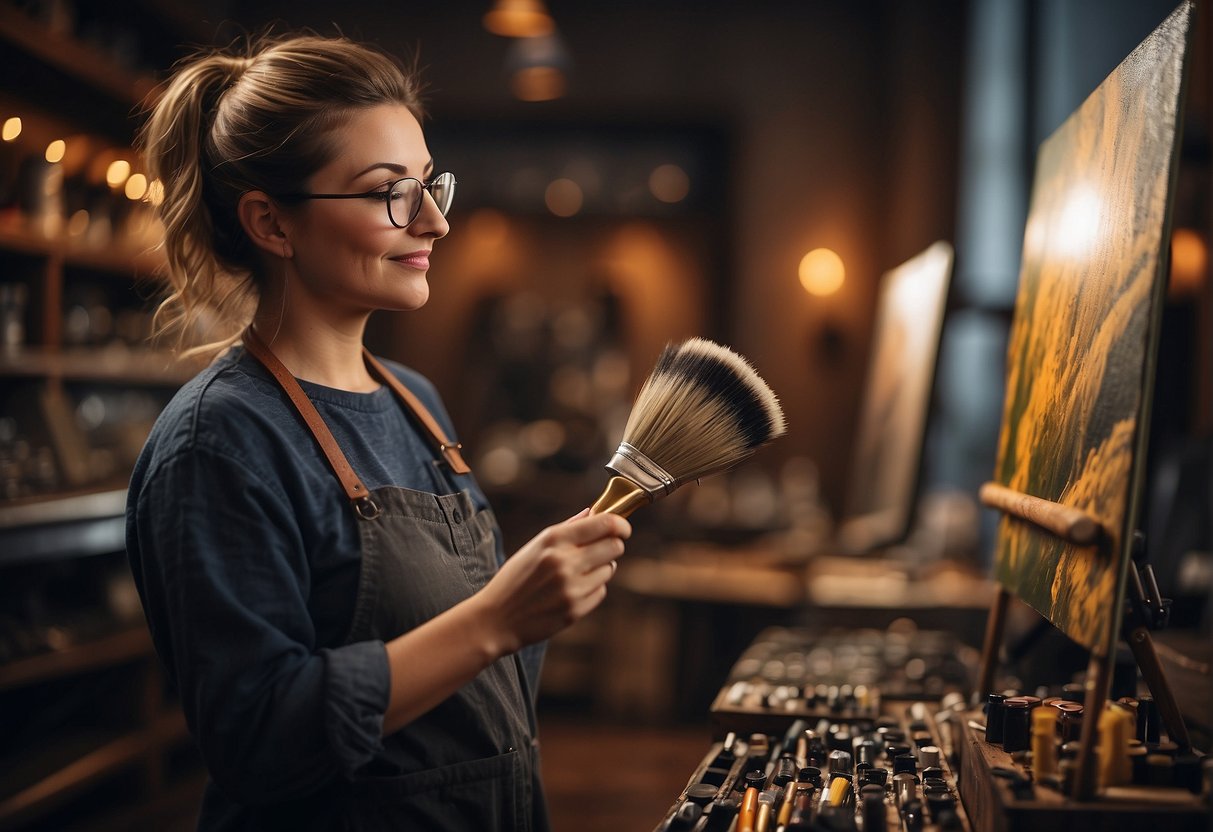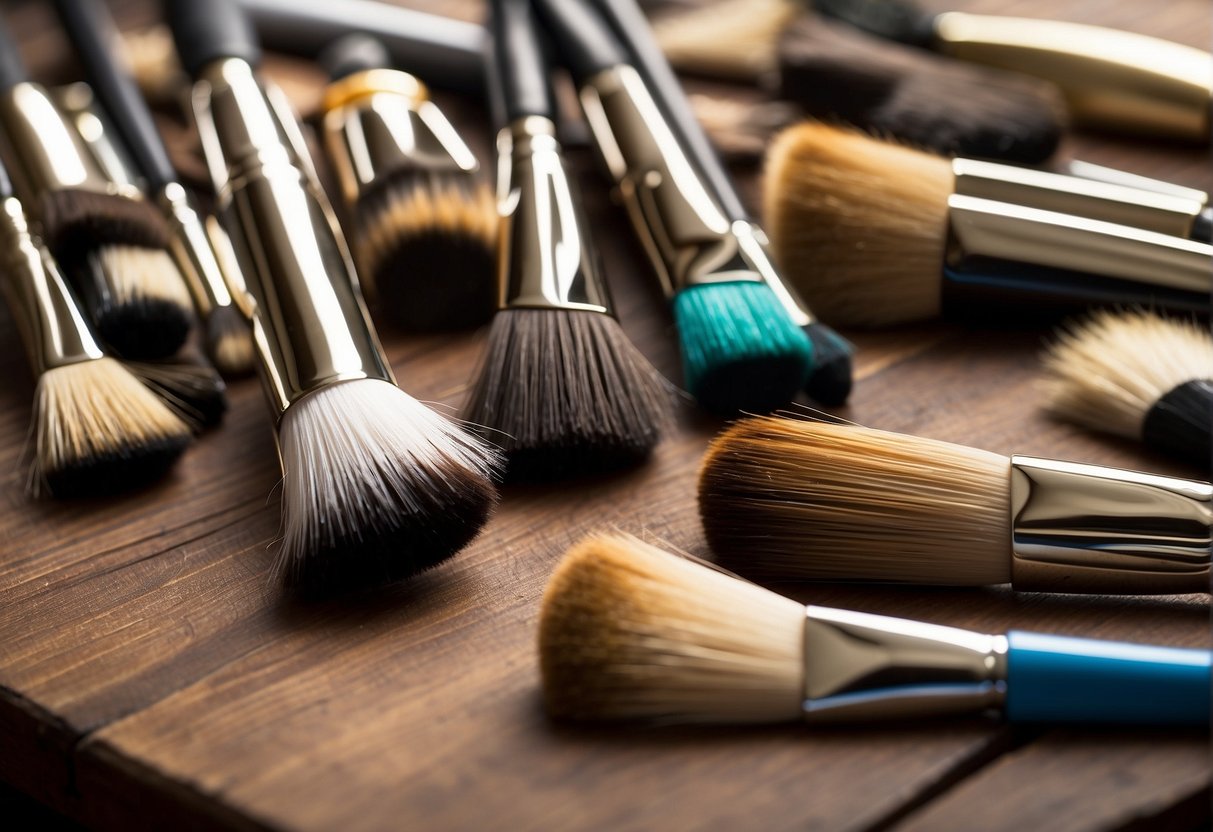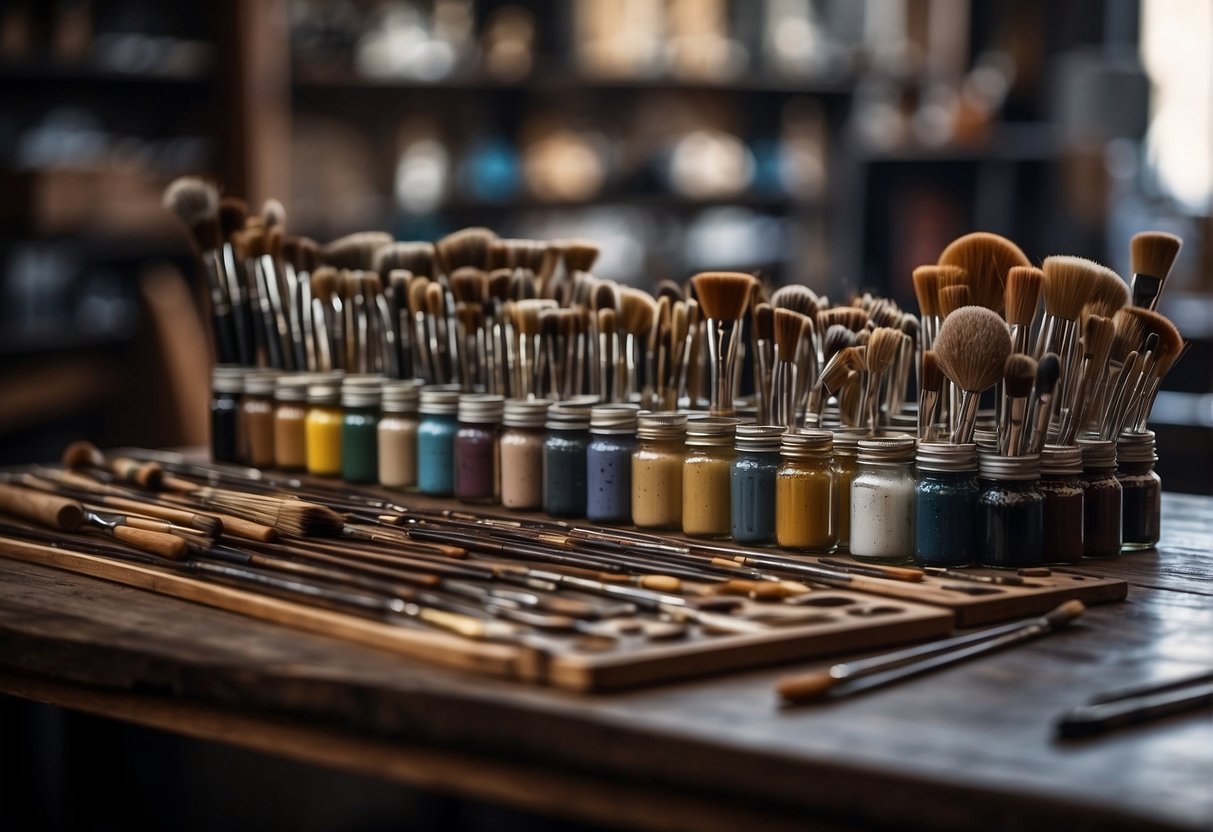As an artist, one of the most common questions I get asked is whether acrylic brushes can be used for oil painting. The answer is not as straightforward as a simple yes or no. While it may seem like using the same brush for both mediums would be a convenient solution, it is important to understand the differences between the two materials and the impact they can have on your brushes.
Understanding brush materials is crucial when it comes to selecting the right brush for your medium. Acrylic brushes are typically made with synthetic bristles, while oil brushes are made with natural bristles. The difference in materials can affect how the brush performs with each medium. Acrylic paint is water-based and dries quickly, while oil paint is thicker and takes longer to dry. This means that using an acrylic brush for oil painting could result in the brush becoming damaged or ruined due to the harsh chemicals in oil paint.
Compatibility of acrylic and oil brushes is a topic that requires careful consideration. While it may be tempting to use the same brush for both mediums, it is important to use brushes that are specifically designed for the medium you are working with. Using the wrong type of brush can lead to problems such as the paint not adhering properly to the canvas or the brush becoming damaged. Proper care and maintenance of your brushes is also crucial to their longevity and performance.
Key Takeaways
- Acrylic and oil paints require different types of brushes due to the differences in their chemical makeup.
- Using the wrong type of brush can lead to damage or ruined brushes, as well as problems with the paint adhering to the canvas.
- Proper care and maintenance of your brushes is crucial to their longevity and performance.
Understanding Brush Materials
As an artist, it is essential to understand the different brush materials available to create the best possible artwork. Brushes come in various shapes, sizes, and materials, each with its unique properties, advantages, and disadvantages.
Natural vs Synthetic Fibers
Brush fibers can be natural or synthetic. Natural fibers are sourced from animals such as hog bristle, sable, and squirrel. On the other hand, synthetic fibers are made from nylon, polyester, or a combination of both.
Natural fiber brushes are known for their durability, stiffness, and resilience. They are ideal for oil painting because they can handle the thickness and texture of oil paints. Hog bristle brushes are particularly popular for oil painting because they are stiff and strong, which allows them to move heavy paint around the canvas.
Synthetic fiber brushes, on the other hand, are more affordable and versatile. They can be used with both oil and acrylic paints, which makes them a great choice for artists who work with both media. Synthetic brushes are also easier to clean and maintain than natural fiber brushes.
Brush Shapes and Their Purposes
The shape of the brush determines the type of stroke it creates. Therefore, it is crucial to choose the right brush shape for the desired effect. Some common brush shapes include:
-
Flat: Flat brushes have a rectangular shape and are ideal for creating sharp edges and straight lines.
-
Round: Round brushes have a pointed tip and are perfect for creating thin lines, details, and filling in small areas.
-
Filbert: Filbert brushes have an oval shape and are ideal for blending and creating soft edges.
-
Fan: Fan brushes have a fan-shaped head and are excellent for creating textures and special effects.
When it comes to oil painting, it is essential to choose the right brush material, shape, and size to achieve the desired effect. Natural fiber brushes are perfect for creating texture and depth, while synthetic brushes are great for creating smooth and even strokes.
In conclusion, understanding brush materials is crucial to creating high-quality artwork. As an artist, it is essential to experiment with different brush materials, shapes, and sizes to find the perfect combination for your style and technique.
Compatibility of Acrylic and Oil Brushes
As an artist, I often get asked whether acrylic brushes can be used for oil painting. In this section, I will go over the compatibility of acrylic and oil brushes and their impact on brush lifespan.
Can Acrylic Brushes Be Used for Oil Painting?
Yes, acrylic brushes can be used for oil painting, but it’s not recommended. The reason is that acrylic brushes are typically made with synthetic fibers, which are less flexible than natural hair brushes used for oil painting. The inflexible nature of acrylic brushes can cause cracking in the oil paint over time. Additionally, acrylic brushes are not designed to hold as much paint as oil brushes, which can make it difficult to apply enough paint to the canvas.
Another concern with using acrylic brushes for oil painting is the risk of ruining both paints. Acrylic paints can get contaminated with oil from the brush, which can cause the paint to dry too quickly and ruin the painting. Similarly, oil paints can be difficult to clean from acrylic brushes, which can lead to a buildup of paint and shorten the lifespan of the brush.
Impact on Brush Lifespan
Using acrylic brushes for oil painting can shorten the lifespan of the brush. The synthetic fibers used in acrylic brushes are not designed to withstand the harsh solvents and oil-based mediums used in oil painting. Over time, the solvents and oil can cause the fibers to break down, making the brush unusable.
In conclusion, while it is possible to use acrylic brushes for oil painting, it’s not recommended. The inflexible nature of acrylic brushes, the risk of ruining both paints, and the impact on brush lifespan make it a less than ideal choice. It’s best to invest in a separate set of brushes designed specifically for oil painting to achieve the best results.
Proper Care and Maintenance
As an artist who works with both oil and acrylic paints, I highly recommend investing in two sets of brushes instead of using one set for both. However, if you do use the same brushes for both types of paint, it is important to take proper care and maintenance to ensure the longevity of your brushes.
Cleaning Techniques for Mixed Usage
When cleaning brushes used for both oil and acrylic paints, it is important to start by wiping off as much paint as possible with a rag or paper towel. Then, use a mild soap and lukewarm water to gently clean the bristles. Avoid using hot water, as it can damage the bristles. Rinse the brush thoroughly with warm water, making sure to remove all soap residue.
For oil paint, use a brush cleaner or solvent to remove any remaining paint from the bristles. Be sure to follow the manufacturer’s instructions and use the cleaner in a well-ventilated area. After cleaning, rinse the brush with warm water and reshape the bristles.
For acrylic paint, you can use a brush cleaner or soap and water to clean the brush. Again, make sure to rinse the brush thoroughly with warm water and reshape the bristles.
Preserving Brush Shape and Flexibility
Proper brush care is essential to preserving the shape and flexibility of your brushes. After cleaning, gently reshape the bristles and allow the brush to dry completely before storing it. Avoid leaving brushes standing in water or solvent, as this can damage the bristles.
For long-term storage, store brushes in a container or case that will protect them from dust and damage. If you need to transport your brushes, consider using a brush roll or case that will keep them organized and protected.
In conclusion, while it is best to use separate brushes for oil and acrylic paints, it is possible to use the same brushes for both with proper care and maintenance. By following these cleaning and preservation techniques, you can ensure that your brushes will last for many painting sessions.
Selecting the Right Brush for Your Medium
As an artist, selecting the right brush for your medium is crucial for achieving the desired results in your artwork. When it comes to choosing brushes, there are several factors to consider, including the medium you are working with, the texture of your painting surface, the size and shape of the brush, the tip, and the handle.
Factors to Consider When Choosing Brushes
The type of brush you use depends on the medium you are working with. While acrylic and oil paints look similar, they have different properties and require different types of brushes. It is essential to use brushes that are specifically designed for the medium you are using.
Another factor to consider when selecting brushes is the texture of your painting surface. A rough canvas requires a stiffer brush, while a smoother surface requires a softer brush.
The Rule of Thumb for Brush Selection
The rule of thumb for selecting brushes is to use a larger brush for larger areas and a smaller brush for smaller areas. The size of the brush also depends on the effect you want to create. For example, if you want to create fine details, you will need a smaller brush with a pointed tip.
The shape of the brush is also important. Flat brushes are ideal for covering large areas, while round brushes are perfect for creating fine details and lines. Fan brushes are used to create texture, while filbert brushes are used for blending and smoothing.
The handle of the brush is another important consideration. A long handle is ideal for painting at an easel, while a short handle is better for painting on a table. The material of the handle can also affect the grip and comfort of the brush.
In conclusion, selecting the right brush for your medium is crucial for achieving the desired results in your artwork. Consider the texture of your painting surface, the size and shape of the brush, the tip, and the handle when making your selection. Remember to use brushes that are specifically designed for the medium you are working with, and follow the rule of thumb for brush selection.
Advanced Techniques and Tips
Mixing Mediums and Their Effects on Brushes
As an artist, I experiment with different mediums to achieve the desired effect in my artwork. However, it is important to note that mixing mediums can have an impact on brushes. For example, using oil paint with acrylic medium can cause the bristles of an acrylic brush to become stiff and lose their shape. Similarly, using acrylic paint with oil medium can cause the bristles to become too soft and not hold their shape.
To avoid damaging your brushes, it is best to use brushes specifically designed for the medium you are working with. If you are using both oil and acrylic paints, consider investing in separate sets of brushes for each medium. This may seem expensive, but it will save you money in the long run by extending the life of your brushes.
Adapting Brush Techniques for Multiple Paint Types
Adapting brush techniques for multiple paint types is essential for any artist who works with both oil and acrylic paints. While some techniques can be used for both types of paint, others may need to be adapted to achieve the desired effect.
For example, when using oil paint, I often use a glazing technique to create depth and luminosity in my artwork. However, this technique does not work as well with acrylic paint because it dries too quickly. Instead, I use a layering technique with acrylic paint to achieve a similar effect.
When adapting brush techniques for multiple paint types, it is important to consider the properties of each medium. For example, oil paint is thicker and takes longer to dry, while acrylic paint is thinner and dries quickly. By understanding these properties, you can adapt your brush techniques to achieve the desired effect with each medium.
In conclusion, using acrylic brushes for oil paint is not recommended as it can damage the brushes. However, if you must use acrylic brushes for oil paint, be sure to clean them thoroughly after each use and avoid mixing mediums. Adapting brush techniques for multiple paint types is essential for any artist who works with both oil and acrylic paints. By understanding the properties of each medium and using brushes specifically designed for each medium, you can achieve the desired effect in your artwork.
Frequently Asked Questions
What are the key differences between acrylic and oil paint brushes?
The main difference between acrylic and oil paint brushes is the type of bristles used. Acrylic brushes are typically made with synthetic bristles, while oil paint brushes are made with natural bristles. This is because oil paint is thicker and more viscous than acrylic paint, so it requires a stiffer brush with more resilience to handle the texture of the paint.
How do you properly clean brushes after using them with oil paint?
Cleaning brushes after using them with oil paint is crucial to maintain their quality and longevity. First, wipe off any excess paint using a paper towel or rag. Then, rinse the brush in a container of odorless mineral spirits or turpentine. Repeat this process until the brush is clean. Finally, wash the brush with soap and water and reshape the bristles. Allow the brush to dry completely before storing it.
What are the best types of brushes to use for oil painting?
The best types of brushes to use for oil painting are those made with natural bristles, such as hog hair, sable, or mongoose. These brushes are able to handle the thicker consistency of oil paint and can create a variety of textures and effects.
Is it possible to use the same brushes for both acrylic and oil painting?
While it is possible to use the same brushes for both acrylic and oil painting, it is not recommended. Acrylic paint can be harsh on natural bristles and can cause them to break down over time. It is best to use separate brushes for each type of paint to ensure the longevity of the brushes.
Can watercolor brushes be effectively used for oil painting?
Watercolor brushes are not recommended for oil painting. They are typically made with soft bristles that are not strong enough to handle the texture of oil paint. Additionally, watercolor brushes are often made with synthetic bristles, which can be damaged by the solvents used to clean oil paint brushes.
Are there any specific brush materials that are better suited for oil painting compared to others?
As mentioned earlier, natural bristle brushes are best suited for oil painting. Within the natural bristle category, hog hair brushes are the most commonly used and are suitable for a wide range of oil painting techniques. Sable and mongoose brushes are also popular choices for oil painting, but they can be more expensive.

Hi, I’m Sal Muller of Tooltrip.com. My DIY experience led me to understand essential power tools for home projects. Tooltrip.com guides enthusiasts and professionals in choosing right tools for any job. I provide concise top tool reviews for easier, efficient DIY.





